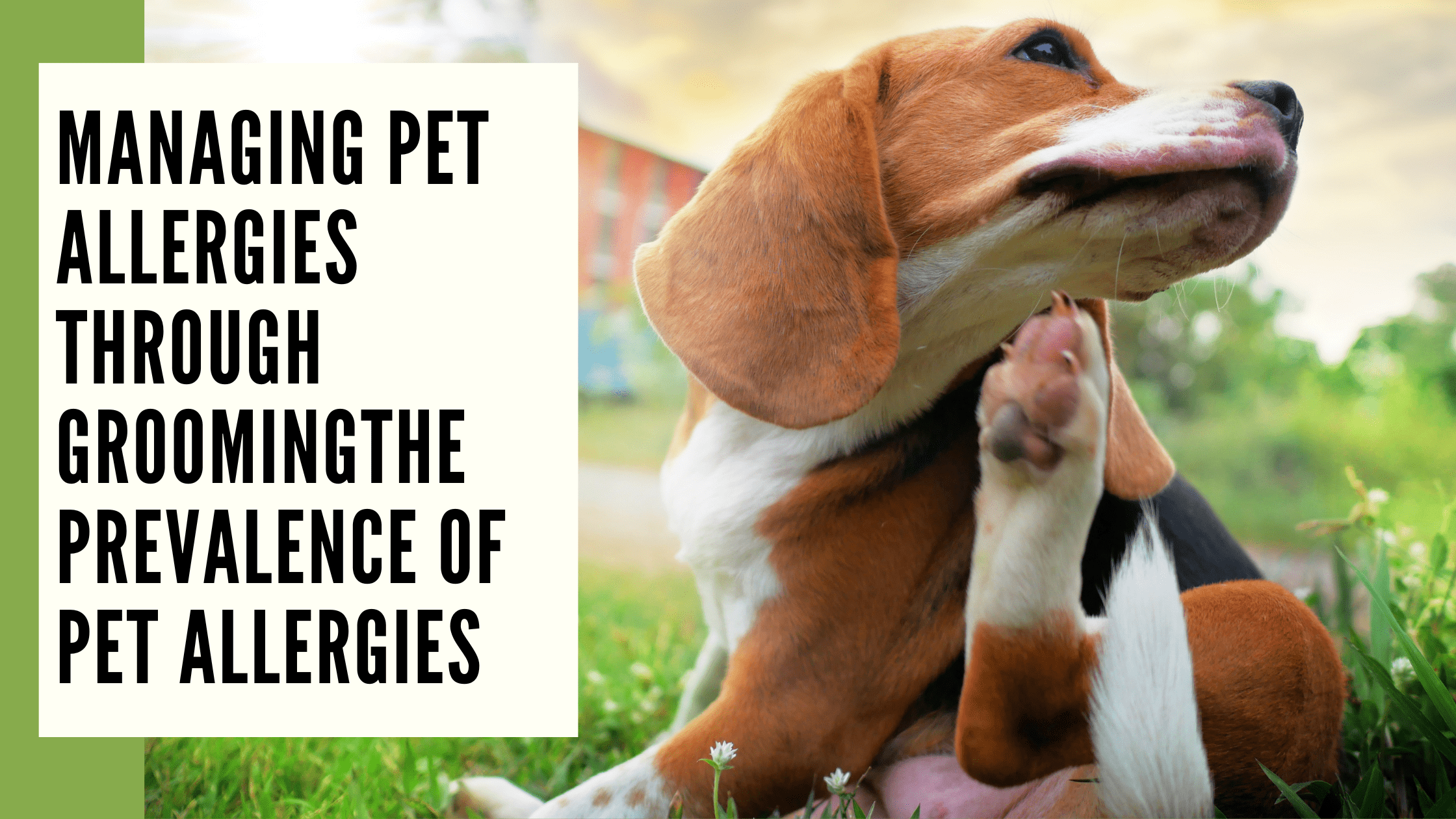Managing Pet Allergies through Grooming The Prevalence of Pet Allergies
If you’ve ever found yourself sneezing, itching, or wheezing around your furry friends, you’re not alone. Pet allergies are a common issue, affecting millions of people worldwide. The good news? There are effective ways to manage these allergies, and one of the best strategies is through proper grooming.
The Role of Grooming in Managing Allergies
Grooming isn’t just about keeping your pet looking sharp; it’s a crucial part of reducing allergens and keeping both you and your pet healthy. Let’s dive into how regular grooming can make a big difference in managing pet allergies.
Understanding Pet Allergies
Common Allergens
Pet allergies are usually triggered by proteins found in an animal’s skin cells, urine, and saliva. These proteins can stick to the fur and be released into the air or onto surfaces when your pet sheds.
| Allergen Source | Description |
| Skin cells | Dander from shedding |
| Urine | Proteins in pet urine |
| Saliva | Proteins in pet saliva spread via licking |
Symptoms of Pet Allergies
Common symptoms include sneezing, runny or stuffy nose, itchy or watery eyes, and even asthma attacks. It’s important to identify these symptoms early to manage them effectively.
| Symptom | Description |
| Sneezing | Frequent, often with nasal discharge |
| Runny/Stuffy Nose | Persistent nasal congestion |
| Itchy/Watery Eyes | Irritation and tearing |
| Asthma Attacks | Breathing difficulties |
The Importance of Regular Grooming
Reducing Allergen Levels
Regular grooming helps remove loose fur and dander, the main carriers of allergens. Brushing your pet frequently can significantly reduce the amount of dander they shed, making your home a more allergy-friendly environment.
| Grooming Activity | Benefit |
| Brushing | Reduces loose fur and dander |
| Bathing | Washes away allergens |
| Nail Trimming | Prevents scratches that spread dander |
Enhancing Pet and Owner Health
Consistent grooming not only reduces allergens but also promotes better health for your pet. It can prevent matting, skin infections, and other health issues that can exacerbate allergies.
Basic Grooming Techniques
Brushing
Brushing your pet daily can drastically reduce the amount of loose fur and dander in your home. Use a brush suitable for your pet’s coat type to ensure you are effectively removing loose hair.
| Pet Type | Brush Type | Frequency |
| Short-haired | Rubber brush | Daily |
| Long-haired | Slicker brush | Daily |
| Double coat | Undercoat rake | Twice a week |
Bathing
Bathing your pet with hypoallergenic shampoo can help wash away allergens. Aim to bathe your pet once a month, but be careful not to overdo it, as excessive bathing can dry out their skin.
| Pet Type | Shampoo Type | Frequency |
| Dogs | Hypoallergenic | Monthly |
| Cats | Gentle cat shampoo | Every 6 weeks |
| Small animals | Mild pet shampoo | As needed |
Advanced Grooming Techniques
Professional Grooming Services
Sometimes, professional help is the way to go. Groomers have specialized tools and expertise to handle even the most challenging grooming tasks. Regular visits to a professional groomer can keep your pet’s coat in top condition.
Specialized Grooming Tools
Investing in high-quality grooming tools can make a big difference. Tools like deshedding brushes, grooming gloves, and high-efficiency particulate air (HEPA) filters in your vacuum can help keep allergens at bay.
| Tool Type | Benefit |
| Deshedding brushes | Removes loose fur and dander |
| Grooming gloves | Gentle on skin, good for bonding |
| HEPA vacuum filters | Captures airborne allergens |
Grooming for Different Types of Pets
Dogs
Different dog breeds have different grooming needs. For instance, long-haired breeds like Golden Retrievers require more frequent brushing compared to short-haired breeds like Beagles.
| Dog Breed | Grooming Needs | Frequency |
| Golden Retriever | Brushing, bathing | Weekly |
| Beagle | Brushing | Weekly |
| Poodle | Professional grooming | Every 6 weeks |
Cats
Cats are generally good at grooming themselves, but they still benefit from regular brushing, especially long-haired breeds. This reduces shedding and the amount of dander they spread.
| Cat Breed | Grooming Needs | Frequency |
| Persian | Brushing, bathing | Weekly |
| Short-haired cats | Brushing | Bi-weekly |
| Sphynx | Bathing | Monthly |
Small Animals (Rabbits, Guinea Pigs, etc.)
Even small pets need grooming. Regular brushing and occasional baths can help reduce allergens from these animals as well.
| Small Animal | Grooming Needs | Frequency |
| Rabbit | Brushing | Weekly |
| Guinea Pig | Brushing, nail trim | Bi-weekly |
| Ferret | Bathing | Monthly |
Seasonal Grooming Tips
Spring and Summer
During warmer months, pets shed more. Increase grooming frequency to manage the extra fur and dander.
| Season | Grooming Focus | Frequency |
| Spring | Shedding control | Daily brushing |
| Summer | Bathing, brushing | Bi-weekly bath |
Fall and Winter
Pets grow thicker coats in colder months. Regular grooming helps prevent matting and keeps their skin healthy.
| Season | Grooming Focus | Frequency |
| Fall | Coat maintenance | Weekly brushing |
| Winter | Skin health | Monthly bath |
Diet and Allergies
The Connection Between Diet and Skin Health
A healthy diet can improve your pet’s skin and coat health, reducing the amount of allergens they produce. Look for foods rich in omega-3 and omega-6 fatty acids.
| Nutrient | Benefit |
| Omega-3 fatty acids | Reduces inflammation |
| Omega-6 fatty acids | Improves skin barrier |
| Vitamin E | Antioxidant, skin health |
Best Foods for Reducing Allergies
Consider hypoallergenic pet foods if your pet has food sensitivities. These can reduce skin irritation and dander production.
| Food Type | Benefit |
| Hypoallergenic kibble | Reduces skin reactions |
| Fish-based diets | Rich in omega-3s |
| Grain-free diets | Suitable for sensitive pets |
Environmental Control
Cleaning the Home Environment
Regular cleaning can significantly reduce allergens in your home. Vacuum carpets, wash bedding, and clean furniture regularly.
| Cleaning Task | Frequency | Tips |
| Vacuuming | Weekly | Use HEPA filter vacuum |
| Washing pet bedding | Weekly | Hot water wash |
| Cleaning furniture | Bi-weekly | Pet-safe cleaning products |
Using Air Purifiers
Air purifiers with HEPA filters can capture airborne allergens, making the air cleaner and easier to breathe.
| Purifier Feature | Benefit |
| HEPA filter | Captures small particles |
| Activated carbon | Reduces odors |
| UV light | Kills airborne bacteria and viruses |
Regular Veterinary Checkups
Importance of Health Monitoring
Regular vet visits ensure your pet’s health is monitored and any issues are addressed promptly. This can prevent health problems that might increase allergen production.
| Vet Visit Frequency | Importance |
| Annual checkup | General health monitoring |
| Bi-annual for seniors | More frequent health assessment |
| As needed | Address specific issues promptly |
Vaccinations and Preventative Measures
Keep your pet’s vaccinations up to date and follow preventative measures to ensure they stay healthy and happy.
| Preventative Measure | Benefit |
| Vaccinations | Prevents diseases |
| Flea/tick control | Reduces allergen sources |
| Regular deworming | Prevents internal parasites |
Natural Remedies for Pet Allergies
Herbal Solutions
Some herbs like chamomile and oatmeal can soothe your pet’s skin and reduce dander. Look for pet-safe herbal shampoos and conditioners.
| Herb | Benefit |
| Chamomile | Soothes irritated skin |
| Oatmeal | Moisturizes and relieves itching |
| Aloe Vera | Hydrates and heals |
Homeopathic Treatments
Homeopathic treatments can offer relief for both pets and owners suffering from allergies. Always consult with a vet before trying new remedies.
| Treatment | Benefit |
| Apis mellifica | Reduces swelling and itching |
| Sulphur | Treats skin irritation |
| Arsenicum album | Alleviates digestive issues |
Over-the-Counter Treatments
Shampoos and Sprays
Hypoallergenic shampoos and sprays can help manage allergens on your pet’s coat. Look for products specifically designed to reduce dander.
| Product Type | Benefit |
| Hypoallergenic shampoo | Reduces skin irritation |
| Anti-itch spray | Provides immediate relief |
| Moisturizing conditioner | Keeps skin healthy |
Antihistamines and Supplements
Over-the-counter antihistamines can help manage symptoms in both pets and humans. Consult with a vet before giving any medication to your pet.
| Treatment | Benefit |
| Antihistamines | Reduces allergic reactions |
| Omega supplements | Improves skin and coat health |
| Probiotics | Supports immune function |
Dealing with Severe Allergies
Allergy Shots and Immunotherapy
For severe allergies, allergy shots and immunotherapy can be effective treatments. These methods help your body build up resistance to allergens over time.
| Treatment | Benefit |
| Allergy shots | Gradual reduction of sensitivity |
| Sublingual immunotherapy | Easy at-home treatment |
| Specific immunotherapy | Tailored to individual allergens |
Consulting an Allergist
If pet allergies are significantly impacting your life, consulting an allergist can provide personalized treatment options and advice.
| Allergy Test | Benefit |
| Skin prick test | Identifies specific allergens |
| Blood test | Measures immune response |
| Patch test | Detects delayed allergic reactions |
Educating Pet Owners
Resources and Support Groups
There are many resources and support groups available for pet owners dealing with allergies. Joining a community can provide support and tips for managing allergies.
| Resource Type | Benefit |
| Online forums | Share experiences and advice |
| Local support groups | In-person support and resources |
| Educational websites | Reliable information and tips |
Training and Behavior Adjustment
Training your pet to stay off furniture or out of certain rooms can reduce allergen exposure. Behavioral adjustments can make a big difference in managing allergies.
| Training Strategy | Benefit |
| No furniture rule | Reduces allergens on surfaces |
| Designated pet areas | Limits allergen spread |
| Positive reinforcement | Encourages good behavior |
Conclusion
Managing pet allergies through grooming is a practical and effective approach. Regular grooming, combined with environmental control and proper diet, can significantly reduce allergens and improve the quality of life for both you and your pet. By staying proactive and informed, you can enjoy the companionship of your furry friends without the discomfort of allergies.
You May Also Like : Understanding Your Pet’s Skin Health
FAQs
1. How often should I groom my pet to reduce allergies?
Aim to brush your pet daily and bathe them once a month with hypoallergenic shampoo.
2. Can diet affect my pet’s allergen levels?
Yes, a healthy diet can improve your pet’s skin and coat health, reducing the amount of allergens they produce.
3. Are there specific grooming tools that help with allergies?
Yes, tools like deshedding brushes, grooming gloves, and HEPA filters in vacuums can help manage allergens.
4. What are some natural remedies for pet allergies?
Herbal solutions like chamomile and oatmeal shampoos can soothe your pet’s skin and reduce dander.
5. When should I consult an allergist for pet allergies?
If pet allergies are significantly impacting your life, consulting an allergist can provide personalized treatment options and advice.









